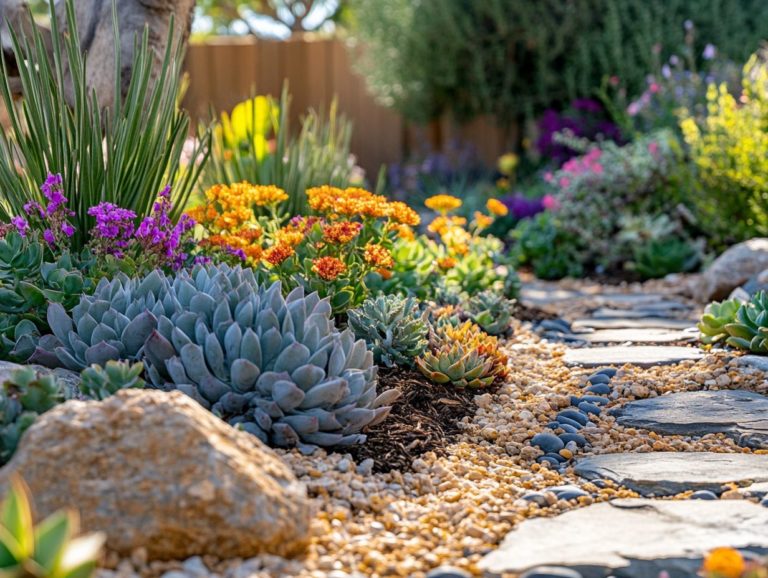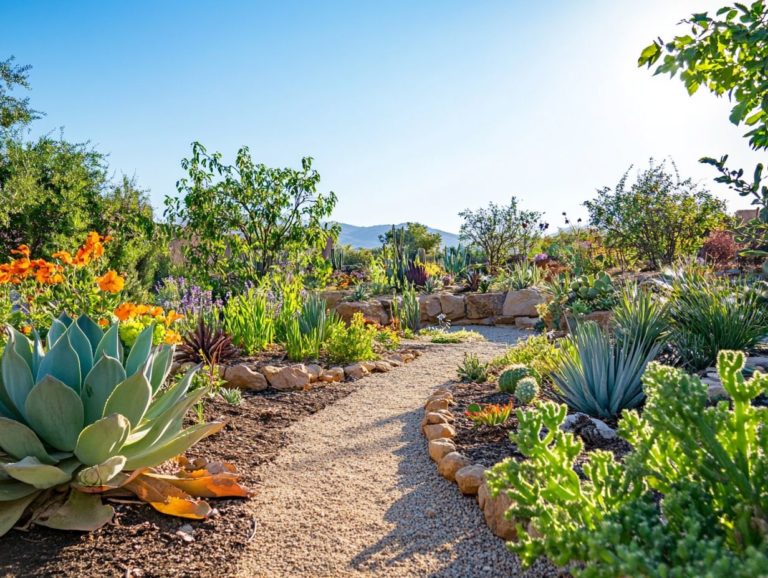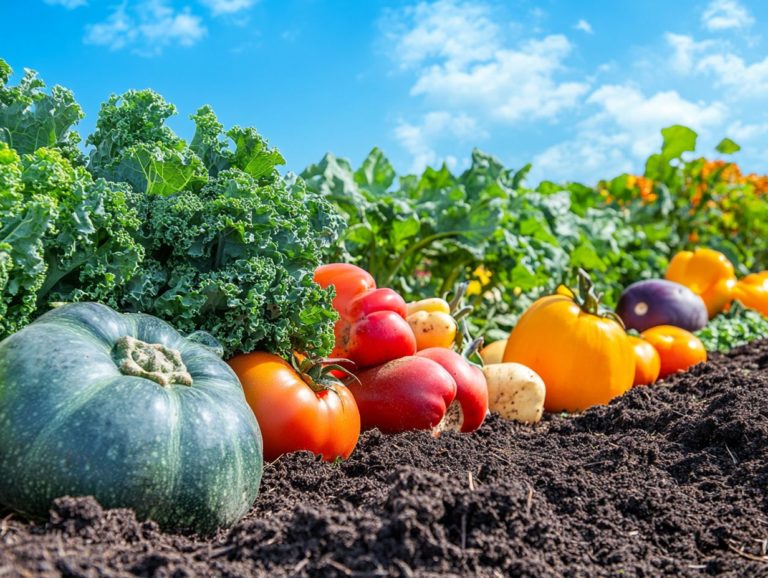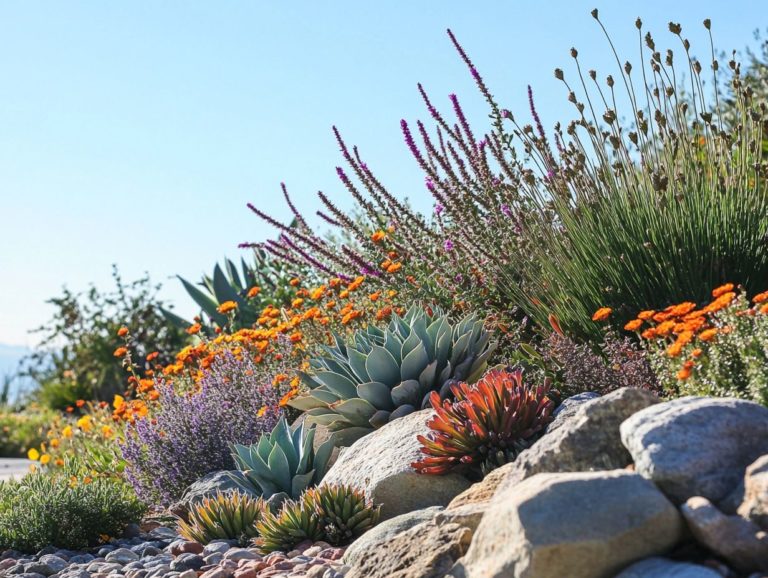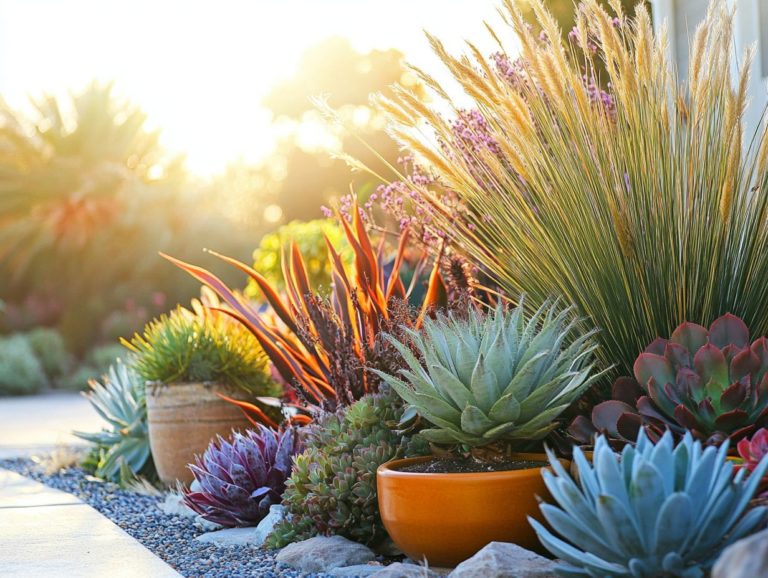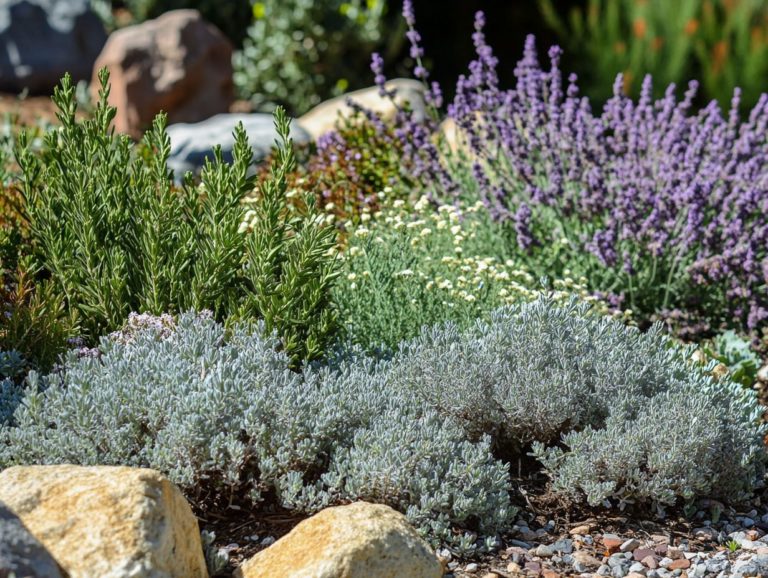Best Ornamental Grasses for Dry Landscapes
Creating a captivating landscape in dry conditions presents a unique challenge. Drought-tolerant ornamental grasses offer a stunning solution.
These resilient plants thrive with minimal water. They introduce texture, movement, and vibrant colors to your garden, making them great for pollinators.
Dive into what makes these grasses drought-tolerant. Explore their benefits for dry landscapes and discover ten exceptional varieties, like Blue Oat Grass, that can elevate your outdoor space.
Check out design ideas for container gardens and plant pairings that will keep your garden thriving, even in tough conditions.
Contents
- Key Takeaways:
- 1. Drought-Tolerant Ornamental Grasses
- 2. Blue Fescue (Festuca glauca)
- 3. Feather Reed Grass (Calamagrostis x acutiflora)
- 4. Maiden Grass (Miscanthus sinensis)
- Switchgrass (Panicum virgatum)
- 6. Purple Fountain Grass (Pennisetum setaceum)
- 7. Little Bluestem (Schizachyrium scoparium)
- 8. Mexican Feather Grass (Nassella tenuissima)
- 9. Sideoats Grama (Bouteloua curtipendula)
- 10. Indian Grass (Sorghastrum nutans)
- 11. Big Bluestem (Andropogon gerardii)
- Benefits for Dry Landscapes
- Frequently Asked Questions
- Discover the best ornamental grasses for your dry landscape!
- Do ornamental grasses require a lot of water?
- Can ornamental grasses add texture and visual interest to a dry landscape?
- Are there any low-maintenance ornamental grasses for dry landscapes?
- Can ornamental grasses attract wildlife to a dry landscape?
- How can I incorporate ornamental grasses into my dry landscape design?
- Frequently Asked Questions
Key Takeaways:
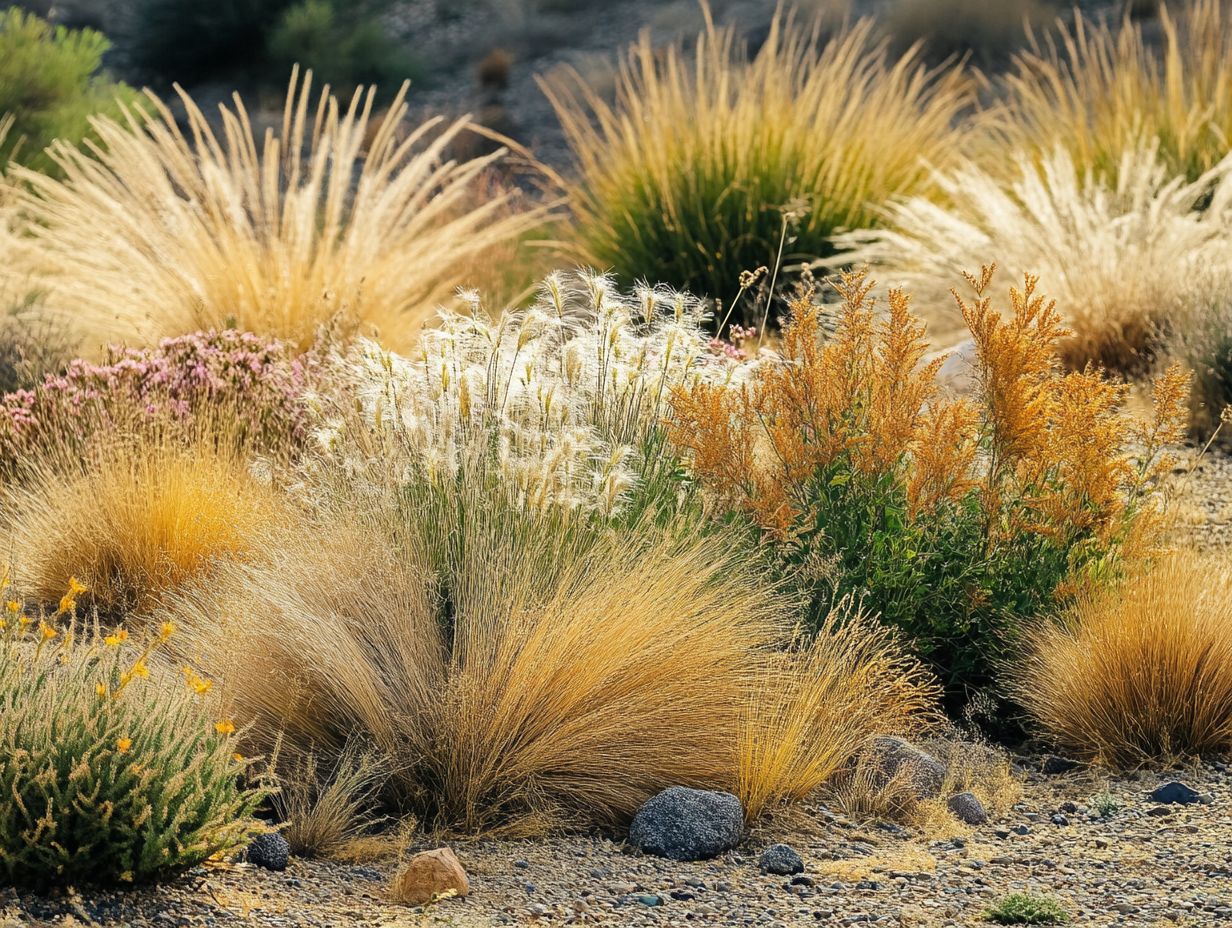
- Drought-tolerant grasses are perfect for dry landscapes. They require less water and maintenance while still bringing beauty and texture to the garden.
- Blue Fescue, Feather Reed Grass, and Maiden Grass are excellent choices for low-water conditions. They add interest and vibrancy to your outdoor space.
- When designing with ornamental grasses, pair them with other drought-resistant plants. Vary heights and textures for a visually appealing and sustainable garden.
1. Drought-Tolerant Ornamental Grasses
Drought-tolerant ornamental grasses are key to landscape design. They help create sustainable, water-wise gardens that thrive in full sun.
These grasses support native species and attract delightful pollinators like butterflies. With vibrant foliage, they add texture and summer interest to borders.
These resilient plants grow well in various soil types, from sandy to clay. By incorporating them, you achieve both beauty and ecosystem benefits.
Their fibrous roots improve soil structure, prevent erosion, and retain moisture. These grasses are essential for soil health.
You’ll love how easy these grasses are to care for! This helps reduce your reliance on chemical fertilizers and irrigation.
2. Blue Fescue (Festuca glauca)
Blue Fescue is a highly sought-after drought-tolerant grass. Its striking blue-gray foliage stands out in any garden.
This ornamental grass thrives in well-draining soil and enjoys full sun. It requires minimal upkeep, making it ideal for busy gardeners.
Its resilience against harsh conditions makes Blue Fescue not just beautiful but also functional. It helps stabilize soil and provides habitat for beneficial insects.
Its compact growth habit pairs well with various perennials and shrubs, adding texture and contrast.
Characteristics and Growing Conditions
Blue Fescue thrives in well-draining soil and full sun. It reaches 6 to 12 inches in height and spreads up to 12 inches wide. The blue-green foliage adds stunning contrast to your garden.
This ornamental grass is typically found in zones 4 to 8. It exhibits remarkable resilience against heat and drought, making it perfect for arid landscapes. You ll appreciate its compact growth habit, with color variations ranging from soft blue to silvery hues.
This hardy grass elevates your garden’s aesthetic appeal while supporting low-water lawn practices. It requires minimal maintenance, making it a practical option for blending beauty with sustainability.
Benefits for Dry Landscapes
Blue Fescue is perfect for dry landscapes. Its low water needs and drought resilience make it a cornerstone of any water-wise garden alongside plants like Panic grass.
This resilient grass not only enhances the aesthetic of your outdoor spaces with its vibrant blue-green hue and delicate texture; it also conserves precious water resources. Its deep root system helps prevent soil erosion, protecting your garden from damaging runoff and sediment loss.
Blue Fescue also provides an excellent habitat for pollinator gardens, attracting butterflies and beneficial insects that contribute to your ecosystem’s overall health. By incorporating this versatile plant into your landscaping, you ll promote sustainability and enrich the biodiversity of your garden.
Design Ideas and Pairings
Integrating Blue Fescue in your garden offers creative options. Think vibrant garden borders or stunning container gardens that harmonize beautifully with other pollinator-friendly plants like Helictotrichon sempervirens.
The soft, silvery-blue hue melds effortlessly with a variety of flowering plants, such as daylilies and coneflowers, creating eye-catching contrasts in color and texture. Imagine pairing Blue Fescue with taller grasses like Miscanthus or switchgrass to establish dynamic height and movement in your garden.
For a whimsical touch, incorporate it alongside colorful annuals or perennials to enhance your garden’s visual appeal. Its adaptability makes it an ideal choice for stunning compositions, whether you favor a modern minimalist aesthetic or a lush cottage garden. Blue Fescue, paired with Big bluestem, is a versatile gem for any landscape enthusiast.
3. Feather Reed Grass (Calamagrostis x acutiflora)
Feather Reed Grass (Calamagrostis x acutiflora) is a drought-tolerant gem that enhances any garden. This stunning perennial thrives in well-drained soils across USDA hardiness zones 4 to 9.
Its upright growth habit and feathery flower spikes make it a great choice for landscape design. The graceful, swaying plumes introduce an air of elegance while serving as a captivating backdrop for other tall grasses and plants.
Whether positioned in sunny borders or slightly shaded areas, it thrives in both moist and dry conditions. The soft, airy texture brings movement and lightness, enhancing your garden’s visual allure throughout all seasons, especially when those beautiful fall colors emerge.
Start transforming your landscape with Blue Fescue today!
Characteristics and Growing Conditions
Feather Reed Grass stands out with its impressive height and slender, arching leaves. It thrives in well-draining soil and adapts to various sunlight conditions. This makes it an exceptional choice for gardeners across different hardiness zones, which indicate how well plants can survive in different climates.
Typically reaching heights of 3 to 5 feet, this ornamental grass boasts a moderate growth rate. It flourishes in full sun to partial shade, allowing you to seamlessly integrate it into various landscape designs, whether as a striking backdrop for perennial beds or as an essential component of a naturalistic garden.
The elegant form and feathery flower plumes of Feather Reed Grass bloom in late summer, adding vertical interest and texture. This elevates the overall aesthetics of your garden and complements Elijah blue fescue. Feather Reed Grass requires minimal maintenance while enhancing beauty and serving a functional purpose by helping to prevent soil erosion. This grass is a must-have for any garden enthusiast!
Benefits for Dry Landscapes
The benefits of Feather Reed Grass in dry landscapes are remarkable. It boasts exceptional drought tolerance, attracts pollinators, and serves as a stunning vertical element in your landscape design, enhancing the appeal of low-water lawns.
This perennial grass supports diverse pollinator gardens, offering vital habitats for bees and butterflies. Its dense root systems significantly enhance soil health, aiding in moisture retention and preventing erosion crucial in arid environments.
When you plant Feather Reed Grass in groups, you create an eye-catching display that sways gracefully in the wind. This adds movement and texture to your garden. This collective planting forms a natural screen, providing privacy and a sense of tranquility while contributing to overall biodiversity and supporting a variety of native species.
Design Ideas and Pairings
In landscape design, Feather Reed Grass can elevate your garden borders and serve as striking focal points in container arrangements. It offers movement and height that beautifully complement a variety of drought-tolerant plants.
This versatile grass thrives in both formal gardens, where its tidy, upright growth harmonizes with structured evergreens, and in more casual settings, where it lends a soft, natural touch among wildflowers.
Imagine pairing it with the vibrant hues of Black-eyed Susans or the delicate blossoms of Butterfly Weed. Such combinations create a breathtaking contrast that draws the eye and invites admiration.
When you plant it alongside low-maintenance succulents, the tall, feathery plumes of Feather Reed Grass establish a captivating interplay of texture and color, providing a dynamic backdrop that evolves with the seasons.
4. Maiden Grass (Miscanthus sinensis)
Maiden Grass (Miscanthus sinensis) stands out as a premier ornamental grass, celebrated not only for its stunning plumes but also for its graceful, arching form. This remarkable plant elevates the aesthetic appeal of gardens and adapts seamlessly to various growing conditions while demanding minimal water.
Typically reaching heights of three to six feet, Maiden Grass offers an ideal solution for those looking to introduce vertical interest into their landscapes. The foliage transforms throughout the growing season, transitioning from vibrant green to golden tones in the fall, creating a captivating contrast against the ever-changing backdrop of your garden.
In late summer, delicate flower spikes emerge, infusing whimsical charm that attracts pollinators and lends winter interest as they gracefully dry. With its ability to thrive in diverse soil types from sandy loam to heavy clay and its hardiness across zones 4 to 9, Maiden Grass is a versatile favorite among discerning gardeners. Don t miss out on the charm that Maiden Grass brings!
Characteristics and Growing Conditions
Maiden Grass thrives in many soil types, especially well-draining soils. It easily adapts to full sun, making it perfect for both novice and experienced gardeners.
This ornamental grass grows in clumps, reaching 4 to 6 feet in height, depending on the variety. It flourishes in specific climate zones, 5 through 9, allowing it to withstand a wide range of temperatures.
To boost its growth, maintain optimal soil moisture during the establishment phase. Maiden Grass is great for creating natural privacy screens or adding texture to your garden.
Benefits for Dry Landscapes
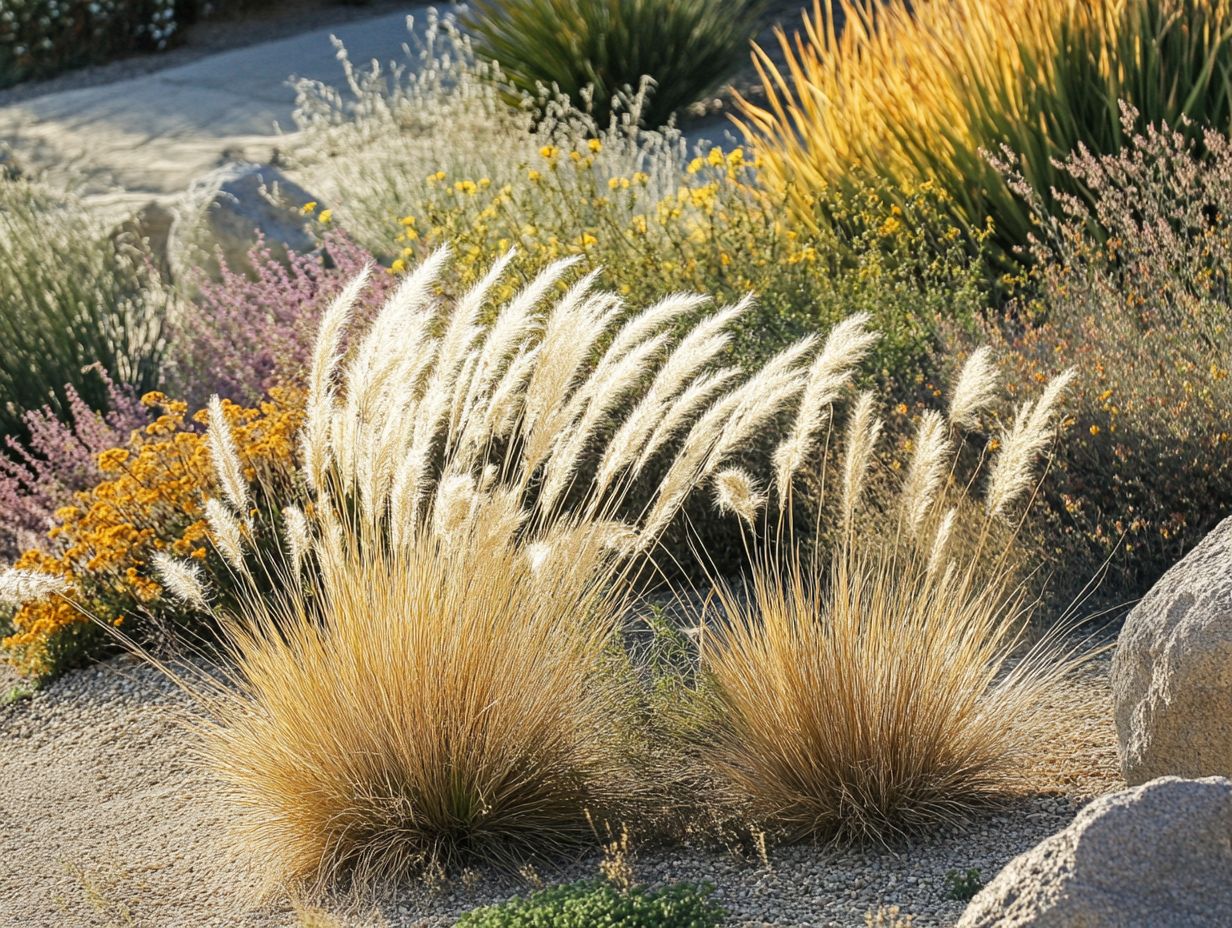
Maiden Grass offers impressive benefits for dry landscapes! Its drought resistance makes it a standout choice and it provides privacy screening too.
This grass attracts pollinators, making it perfect for eco-friendly gardeners. It enhances the beauty of your outdoor space while supporting wildlife.
By adding Maiden Grass to your landscape, you create beautiful focal points or natural barriers. It adds definition while keeping an organic feel.
Design Ideas and Pairings
In landscape design, Maiden Grass is incredibly versatile! It’s perfect for garden borders or as a striking feature in container gardens.
Its graceful plumes sway in the breeze, adding movement and texture. Pair it with flowering perennials like coneflowers to create a colorful tapestry that captivates throughout the seasons.
The tall blades provide a stunning backdrop, especially next to shorter grasses like Blue Fescue. This combination boosts visual interest and ensures seasonal charm in your landscape.
Switchgrass (Panicum virgatum)
Switchgrass is a native ornamental grass that thrives in many environments! It showcases impressive drought tolerance, making it essential for sustainable landscapes.
It reaches up to five feet tall and transforms beautifully with the seasons, from vibrant greens in summer to warm golds in fall. This grass flourishes in loamy to sandy soils and adapts well to different moisture levels.
Its ability to withstand both drought and flooding makes it a must-have for anyone looking to create resilient garden landscapes.
Characteristics and Growing Conditions
Switchgrass thrives in a variety of soil types, particularly relishing well-draining soils. It s perfectly suited for sunny spots in your garden, making it an incredibly adaptable choice for diverse settings.
This robust perennial can flourish in clay, loam, or sandy soils, as long as the drainage is up to par. It prefers a soil acidity level between 5.8 and 7.0, allowing it to perform admirably across different environments.
In terms of hardiness zones, it truly excels in zones 4 through 9, showcasing its impressive resilience to varying weather conditions.
With its deep root systems, switchgrass can tap into moisture and nutrients even during dry spells. Its ability to withstand significant temperature fluctuations makes it a fantastic option for gardeners seeking sustainable, low-maintenance solutions.
Grasping these soil requirements and climate adaptability can greatly enhance your success in cultivating this remarkable plant.
Benefits for Dry Landscapes
The benefits of Switchgrass in dry landscapes are extensive. It showcases remarkable drought resistance, the ability to prevent soil erosion, and its vital role in providing habitat for beneficial pollinators, like bees and butterflies, which are crucial for plant reproduction.
Beyond these advantages, Switchgrass significantly enhances soil health by boosting organic matter content and promoting microbial activity. This paves the way for more fertile ground for your future gardening endeavors.
Its robust structure also fosters a diverse range of wildlife, making it an excellent choice for anyone looking to cultivate biodiversity in their garden spaces.
Visually, Switchgrass brings dynamic movement and texture to landscapes. It creates an inviting atmosphere with its elegant, tall blades swaying gently in the wind.
This versatile plant not only elevates your garden’s aesthetic appeal but also serves practical functions in landscape design, such as offering natural barriers and windbreaks.
Design Ideas and Pairings
In landscape design, you ll find that Switchgrass can serve as a stunning focal point in your garden borders or a striking complement in container gardens. It delivers both visual interest and structural support.
By incorporating this versatile grass, you can create a dynamic backdrop that enhances the beauty of flowering plants like Echinacea or Rudbeckia. These not only bring vibrant colors but also attract pollinators.
Pairing Switchgrass with other ornamental grasses, such as Feather Reed Grass, adds a textured layer to your garden. This creates depth and movement throughout the seasons.
As the weather changes, the golden hues of Switchgrass in the fall contribute to a warm palette. In winter, its fluffy seed heads can catch frost, adding an enchanting touch to your landscape.
Don t miss out on its adaptability; it s a must-have for any garden!
6. Purple Fountain Grass (Pennisetum setaceum)
Purple Fountain Grass (Pennisetum setaceum) is a stunning ornamental grass that you ll appreciate for its vibrant purple foliage and delicate flower plumes. It s an exceptional choice for drought-tolerant landscapes and gardens.
This stunning plant can grow to about 3 to 4 feet tall, adding elegance to your garden. The lush, arching leaves showcase a rich purplish hue that deepens under the sunlight, creating a striking visual contrast against the green backdrop of surrounding flora.
During summer, tiny, fuzzy flower spikes emerge, lending an airy feel that enchants garden enthusiasts like yourself.
Thriving in well-drained soil and basking in full sun, this grass requires minimal watering. This makes it perfect for low-maintenance arrangements and eco-friendly resources.
Its versatility allows it to blend beautifully with both contemporary and traditional garden designs. These designs can include a variety of grasses, such as Helictotrichon sempervirens and Andropogon gerardii, providing texture and movement that effortlessly captivates the eye.
Characteristics and Growing Conditions
Purple Fountain Grass, also known as Pennisetum alopecuroides, thrives in well-drained soil and loves basking in full sun. This makes it an ideal, low-maintenance choice for gardeners across various hardiness zones.
This ornamental grass flourishes in sandy or loamy soils. It is also resilient against drought, making it suitable for plants like Purple needlegrass and Fountain grass once it’s established. With its graceful arching habit and eye-catching purple-hued plumes, it enhances the beauty of your garden, whether as a stunning focal point or a textural element that adds movement to your landscape designs.
Its ability to create a lush backdrop for flowering plants means it integrates beautifully into mixed borders that incorporate vibrant perennials like Salvia yangii. It draws attention with its elegant form and vibrant color especially during the late summer, which is perfect for planting grasses such as Elijah blue fescue, and fall seasons, particularly when combined with plants like Gaillardia grandiflora.
Benefits for Dry Landscapes
The advantages of incorporating Purple Fountain Grass into your dry landscapes are truly remarkable. With its impressive drought tolerance, it not only thrives in arid conditions but also attracts a variety of pollinators. It adds a splash of vivid color that elevates any garden design.
This ornamental grass features an elegant arching form, similar to that of Leatherleaf sedge. It creates a striking contrast with surrounding plants, enhancing the overall aesthetics of your garden compositions. By introducing this exquisite species, you can cultivate a lively environment that welcomes beneficial insects like bees and butterflies.
The unique purple hues that reflect light and attract butterflies of its foliage provide a captivating backdrop, enriching your visual experience while supporting biodiversity, especially when integrated with species like Stipa pulchra and Muhlenbergia rigens.
Purple Fountain Grass is essential for nurturing a healthy ecosystem, making it an exceptional choice for both design and environmental sustainability as it provides an eco-friendly resource.
Design Ideas and Pairings
In landscape design, Purple Fountain Grass stands out as a versatile option. It makes a striking statement in garden borders or serves as a stunning centerpiece in your container gardens, especially when paired with other drought-tolerant plants.
Its elegant, arching plumes create a dynamic contrast, infusing movement into any setting. To elevate its visual appeal, think about pairing it with bright, cascading blooms like vibrant purple petunias or creamy lantanas, which can punctuate your garden with delightful bursts of color.
As the warmer months unfold, this grass showcases stunning purple hues that gracefully transition into more subdued tones come autumn. This ensures your garden remains captivating year-round.
Trim it regularly in early spring for lush growth! Add mulch to keep soil moist, allowing this hardy perennial to thrive even in challenging conditions.
7. Little Bluestem (Schizachyrium scoparium)
Little Bluestem (Schizachyrium scoparium) represents a remarkable choice for your landscape. It boasts striking blue-green foliage and delicate seed heads that bring a touch of elegance. If you’re aiming for a drought-tolerant solution, this native prairie grass is an ideal candidate for a sustainable design.
You ll find this resilient grass flourishing in a variety of soil types. It effortlessly adapts to different garden settings, whether they be sunny meadows or charming mixed borders. With a graceful height typically reaching 2 to 4 feet, it introduces an elegant vertical element that adds texture and visual interest to your gardens throughout the growing season.
Beyond its aesthetic charm, Little Bluestem is hardy in USDA zones 3 to 9, making it a versatile option for gardeners across diverse climates. Whether you re complementing wildflower plantings or enhancing rustic landscapes, this grass contributes to a natural aesthetic that boosts biodiversity and supports local wildlife.
Try these ideas and transform your garden into a vibrant oasis!
Characteristics and Growing Conditions
Little Bluestem flourishes in well-drained soils and full sun, making it a versatile choice for your gardening endeavors, regardless of climate or hardiness zone.
This native grass favors sandy or loamy soils that promote excellent drainage. It can withstand drought conditions, making it an ideal candidate for xeriscaping, which is a gardening method that reduces the need for watering. When you provide it with the right amount of sunlight ideally six to eight hours a day you’ll be rewarded with a striking blue-green hue throughout the growing season.
Its slow to moderate growth rate means it will gradually establish itself, enriching your landscape with its elegant vertical form. Adding this grass to your prairie-style gardens not only enhances beauty but also supports local wildlife, fostering biodiversity within your garden.
Benefits for Dry Landscapes
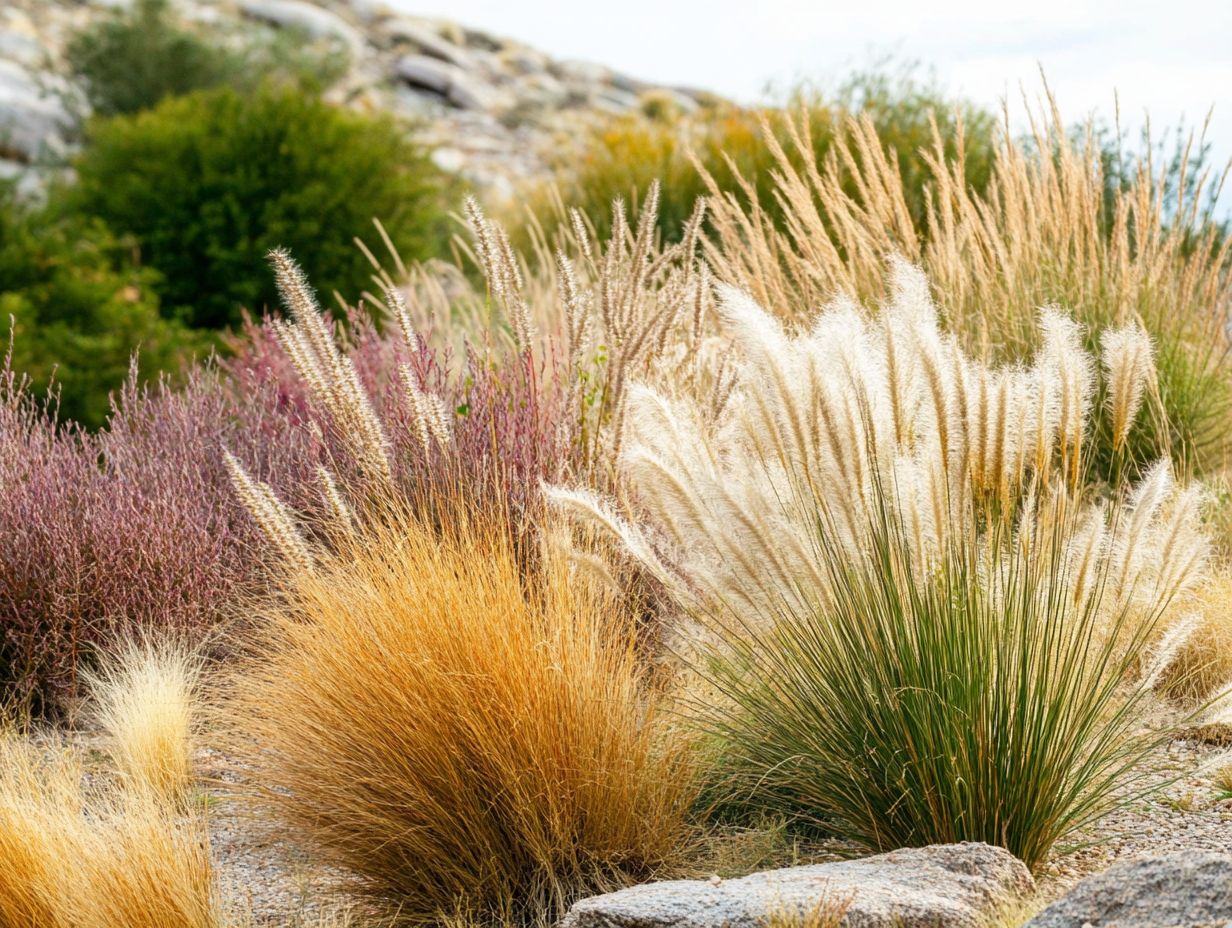
The benefits of Little Bluestem in dry landscapes are truly remarkable, offering you a wealth of advantages. It thrives in arid conditions, making it a superstar in your garden!
This native grass actively improves soil health by preventing erosion and promoting nutrient cycling, making it an essential element of sustainable landscaping. Its deep root system enriches soil structure and enhances water retention, creating a flourishing garden ecosystem.
Little Bluestem also provides a sanctuary for beneficial insects, including various species of bees, butterflies, and predatory insects insects that help control pest populations. With its visually striking plumes that transform into a stunning golden hue in autumn, this resilient grass combines beauty with practicality, fitting seamlessly into any sustainability-focused garden design.
Design Ideas and Pairings
In landscape design, you ll find that Little Bluestem offers striking visual interest in garden borders and serves as a captivating focal point in container gardens. It blends seamlessly with a range of drought-tolerant plants.
Its slender, upright form creates a delicate yet robust presence, especially when paired with vibrant perennials or contrasting foliage. As the seasons change, you’ll notice the warm hues of Little Bluestem shift from early green in spring to deep bronze in autumn, ensuring that your garden remains visually captivating year-round.
By incorporating this grass alongside complementary plants like purple coneflowers or goldenrods, you can enhance textural diversity, resulting in a lush tapestry that elevates your landscape.
Its low maintenance needs make it an ideal choice for both novice and seasoned gardeners seeking impactful yet easy-care design elements. Little Bluestem thrives in poor soils and requires just occasional pruning, making it beneficial for plants like Leatherleaf sedge and Panic grass.
8. Mexican Feather Grass (Nassella tenuissima)
Mexican Feather Grass (Nassella tenuissima) is an exquisite ornamental grass that you ll appreciate for its fine-textured foliage and graceful sway in the breeze, making it a wonderful addition to any drought-tolerant garden design.
Reaching heights of 2 to 3 feet, this grass offers a light and airy silhouette that enhances the visual appeal of various landscapes. Its delicate, wispy leaves create a striking contrast against broader-leafed plants, while its remarkable adaptability allows it to flourish in poor soils, full sun, or partial shade.
This versatility makes it an ideal choice for your low-maintenance gardens, where you can enjoy the beauty of both this grass and other drought-tolerant plants. Not only does it bring captivating movement, but it also acts as a softening element in more structured designs, blending effortlessly with both formal and informal planting schemes.
Characteristics and Growing Conditions
Watch your garden transform as Mexican Feather Grass thrives in well-drained soils and craves sunny spots. It s the perfect addition to your drought-tolerant landscape that showcases the beauty of both Blue Oat Grass and Purple Fountain Grass across various hardiness zones.
Its knack for thriving in poor, sandy soils heightens its desirability, as it demands minimal fertilization, allowing for a more sustainable gardening approach and low maintenance once established. This ornamental grass not only thrives in abundant sunlight but also boasts a graceful, arching form that adds texture and elegance to your garden.
Throughout the growing season, the lush green blades that complement the graceful sway of Mexican Feather Grass create a stunning backdrop for your flowering plants. Ensure it has good air circulation, crucial for the health of grasses such as Zebra Grass, to ward off overwatering, which could lead to root rot. By understanding these specific needs, you can cultivate this beautiful native grass with confidence and success.
Benefits for Dry Landscapes
The benefits of Mexican Feather Grass in dry landscapes are truly remarkable. Its drought tolerance allows you to enjoy a vibrant garden without the constant worry of watering. Plus, its ability to attract pollinators enhances the ecosystem right in your backyard.
This resilient grass also plays a crucial role in promoting biodiversity. By providing essential habitats for pollinators like bees and butterflies, it supports the health of the entire ecosystem. Its dense root system further contributes to soil health by preventing erosion and improving water retention, making it an ideal choice for sustainable landscaping.
Visually, the soft, flowing texture of Mexican Feather Grass brings movement and elegance to your outdoor spaces. It creates a stunning contrast against hardscapes or more rigid plants, making it a standout feature. In essence, Mexican Feather Grass is both an ecological asset and a design essential, enriching both the environment and your garden’s aesthetic.
Design Ideas and Pairings
In landscape design, you can use Mexican Feather Grass to elegantly frame your garden borders or as a striking focal point in container gardens. This grass beautifully complements various drought-tolerant plants.
When paired with hardy succulents like Agave or Echeveria, the graceful texture of the grass introduces a soft contrast against the bold forms of these companions. The delicate wisps of Mexican Feather Grass harmonize beautifully with flowering perennials such as Salvia or Coneflower, enhancing color diversity while attracting pollinators throughout the seasons.
To keep this grass vibrant, give it a good prune in early spring. This encourages fresh growth and prevents overcrowding. Regular watering during its establishment phase, along with the occasional layer of mulch, will help retain moisture, ensuring a lush, beautiful appearance all year round.
9. Sideoats Grama (Bouteloua curtipendula)
Sideoats Grama (Bouteloua curtipendula) is a remarkable native grass that stands out with its unique seed heads and impressive adaptability. This makes it an exceptional choice for sustainable landscaping and drought-tolerant gardens.
Typically growing in clumps and reaching heights of up to two feet, it adds pleasing texture and visual interest to any setting. Its deep root system not only enhances soil stability and prevents erosion but also provides essential habitat for local wildlife, including pollinators and nesting birds.
With a broad range of hardiness zones from 3 to 10 Sideoats Grama flourishes in diverse environments, making it a resilient option for anyone interested in promoting biodiversity. Its tolerance for dry, sandy soils further establishes it as a crucial component in prairie restoration projects and xeriscaping (landscaping that reduces or eliminates the need for irrigation).
Characteristics and Growing Conditions
Sideoats Grama flourishes in well-draining soil and revels in sunny conditions. It is a remarkable choice for those aiming to cultivate landscapes that can survive with little water.
This native grass thrives best in soil that drains quickly and avoids excess moisture. It loves full sun exposure, ideally basking in 6 to 8 hours of sunlight each day.
Its graceful growth habit adds texture and movement to your landscape designs. The elegant arch of its flowering stems beautifully contrasts with more rigid elements.
By incorporating Sideoats Grama into various garden settings, you can enhance the variety of plants and animals, attracting pollinators while creating a stunning backdrop for wildflower displays.
As a low-maintenance option, it allows you to enjoy a vibrant outdoor space without the constant burden of heavy watering or fertilization.
Benefits for Dry Landscapes
The advantages of Sideoats Grama in dry landscapes are remarkable. Its low water requirements make it an ideal choice, while its ability to attract beneficial pollinators enhances the overall ecosystem.
This resilient grass not only thrives in arid conditions but also nurtures biodiversity by providing essential habitats for a variety of wildlife species.
With unique seed heads that bring aesthetic appeal, Sideoats Grama creates visual interest while serving as a food source for birds and other creatures.
It helps prevent soil erosion and promotes healthy ecosystems that support both flora and fauna.
Act now by adding this species to your landscape for a healthier environment that flourishes naturally.
Design Ideas and Pairings
In landscape design, Sideoats Grama can elevate your garden borders, adding visual texture, or serve as a captivating focal point in your container gardens. It harmonizes beautifully with a range of drought-tolerant plants.
This versatile grass thrives in sunny spots, allowing you to creatively blend it with other native species like Blue Grama or vibrant flowering plants such as Coneflower.
Its unique, cascading seed heads and resilient nature enhance the overall aesthetic and bring seasonal interest, as its colors shift throughout the year.
Sideoats Grama requires minimal maintenance, making it an excellent choice for those who desire a low-effort yet visually striking landscape option.
With regular watering during establishment and the occasional trim, you can easily maintain its vibrant appearance, ensuring it remains a lively and attractive part of your garden for years to come.
10. Indian Grass (Sorghastrum nutans)
Indian Grass (Sorghastrum nutans) is a robust native grass that s hard to resist, especially with its striking golden plumes and remarkable adaptability to diverse environments. It s an excellent choice for drought-tolerant landscaping and ecological gardens.
This perennial grass boasts long, slender leaves that create a lush green backdrop. These beautifully contrast with the vibrant seed heads that emerge in late summer and linger through fall.
Not only is its visual appeal delightful, but it also serves a greater purpose by providing essential cover and nourishment for various birds and insects in your garden.
Thriving in well-drained soils, Indian Grass flourishes in numerous growing conditions be it sunny meadows, prairie landscapes, or alongside roadsides.
Its resilience to harsh conditions and ability to enhance soil health firmly establish it as an essential plant for sustainable gardening.
Characteristics and Growing Conditions
Indian Grass flourishes in well-draining soils and thrives in sunny environments. It is an excellent choice for drought-tolerant landscapes across various hardiness zones.
This resilient perennial grass showcases remarkable adaptability, easily growing in diverse soil types, whether sandy or clay-rich, as long as water isn t allowed to pool.
Its roots delve deep into the ground, enabling it to tap into moisture and nutrients even during dry spells.
While it loves basking in full sun, it can manage partial shade, making it a versatile option for a range of garden settings.
With its robust nature and ability to establish itself in challenging conditions, Indian Grass not only promises longevity but also contributes significantly to local biodiversity, providing vital habitats for wildlife.
Benefits for Dry Landscapes
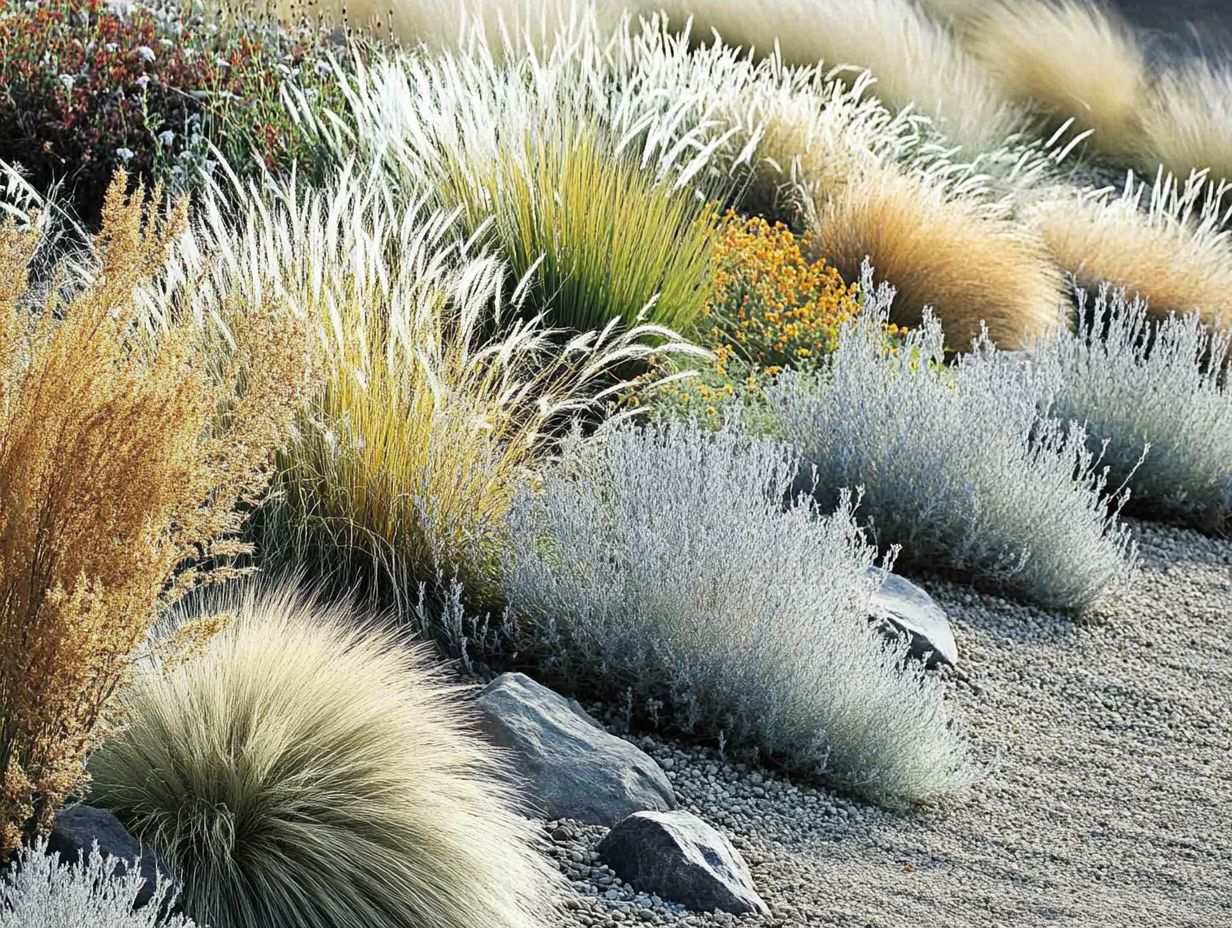
The benefits of Indian Grass in dry landscapes are remarkable. It is drought-resistant and enhances biodiversity while attracting pollinators.
With its tall, graceful stalks, Indian Grass provides cover and nesting sites for various bird species. This creates a sanctuary where local wildlife can thrive.
Its robust root system improves soil health by minimizing erosion and enhancing water retention. This is vital in arid environments.
From an aesthetic perspective, Indian Grass is truly a visual delight. Its feathery seed heads glisten under the sun, while vibrant golden hues come to life in the fall.
Design Ideas and Pairings
In landscape design, Indian Grass can elevate your garden with stunning vertical elements along borders. It also serves as a standout feature in container gardens.
It pairs beautifully with drought-tolerant plants, making it a versatile choice. Combine it with vibrant succulents or flowering perennials for a delightful contrast.
Juxtaposing the golden hues of Indian Grass with the deep greens of sedums or the brilliant blooms of artemisia creates a captivating visual display.
To ensure this resilient plant thrives, provide well-drained soil and moderate watering. Occasional pruning will help it maintain its graceful stature year-round.
11. Big Bluestem (Andropogon gerardii)
Big Bluestem (Andropogon gerardii) is a majestic native grass. It is celebrated for its towering height and striking blue-green hue.
This grass reaches heights of three to seven feet, offering a dramatic visual statement in any garden. Its unique upright form infuses elegance into landscapes.
Big Bluestem has deep roots that prevent soil erosion and improve soil health. It’s an excellent choice for drought-tolerant landscapes and prairie restoration projects.
Characteristics and Growing Conditions
Big Bluestem flourishes in well-drained soils and full sun exposure. It s perfect for gardens designed for dry conditions.
This grass comes to life in sandy or loamy soil that retains moisture without saturation. Its tall, arching stems can soar up to 8 feet, adding striking height to any landscape.
The dense root system of Big Bluestem offers excellent erosion control. Its adaptability allows for seamless incorporation into various settings, from prairie restorations to naturalistic gardens.
In doing so, it fosters a lasting connection to local ecosystems.
Benefits for Dry Landscapes
Big Bluestem offers remarkable benefits in dry landscapes. It shows resilience during drought, supports biodiversity, and adds striking visual appeal to any garden design.
This hardy grass thrives in challenging conditions, serving as an important shelter and food source for various wildlife species. Its tall, graceful form and vibrant autumn colors make it a standout choice for ornamental landscaping, adding dynamic visual interest throughout the seasons.
By fostering a diverse ecosystem, Big Bluestem significantly contributes to soil health and stability, promoting a balanced environment. Adding Big Bluestem to your garden will transform its beauty and enhance local wildlife habitats, offering a sustainable option for environmentally conscious gardeners.
Frequently Asked Questions
Discover the best ornamental grasses for your dry landscape!
Some of the best ornamental grasses for dry landscapes include Blue Oat Grass, Feather Reed Grass, and Switchgrass.
Do ornamental grasses require a lot of water?
No, most ornamental grasses are drought-tolerant and thrive in dry landscapes with minimal water.
Can ornamental grasses add texture and visual interest to a dry landscape?
Yes, ornamental grasses come in a variety of sizes, shapes, and colors, making them a great addition to any dry landscape for added texture and visual interest.
Are there any low-maintenance ornamental grasses for dry landscapes?
Yes, many low-maintenance ornamental grasses are perfect for dry landscapes, such as Prairie Dropseed, Little Bluestem, and Indian Grass.
Can ornamental grasses attract wildlife to a dry landscape?
Yes, many varieties of ornamental grasses can attract birds and butterflies to a dry landscape, making them both beautiful and beneficial for the ecosystem.
How can I incorporate ornamental grasses into my dry landscape design?
Ornamental grasses can be used as a focal point, border, or filler in a dry landscape. They can also be planted in clusters or mixed with other drought-tolerant plants for a diverse and visually appealing design.

